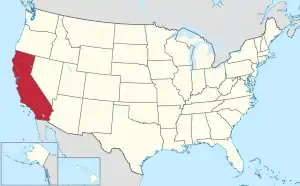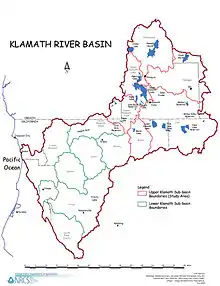Klamath County, California
Klamath County was a county of California from 1851 to 1874. During its existence, the county seat moved twice and ultimately portions of the territory it once had were carved up and added to nearby counties. It was formed from the northwestern portion of Trinity County, and originally included all of the northwestern part of the state, from the Mad River in the south to Oregon in the north, from the Pacific Ocean in the west to the middle of what is now Siskiyou County in the east. It is the only county in California to be disestablished.[1]
Klamath County | |
|---|---|
 | |
 Location within the U.S. state of California | |
 California's location within the U.S. | |
| Coordinates: 41°N 123°W | |
| Country | |
| State | |
| Founded | 1851 |
History
The original county seat was Trinidad, on the county's southwestern coast. In 1854 the county seat was moved to Crescent City, because of its larger population. But the western portion of the county was unrepresentative of the mining interests in the eastern portion of the county, and so, in 1856, the county seat was moved inland, to Orleans Bar, now Orleans.[1] In 1857, Del Norte County, including Crescent City, was split off from Klamath County.
The county's economy was never healthy after the gold rush. The area was contested with Native American tribes. The "Klamath and Salmon River Indian "War" and the 1858-1864 "Bald Hills War" involved white vigilantes hunting down and killing most adult males and killing, capturing, or enslaving women and children. Many of the captive natives subsequently died of starvation and exposure at Fort Humboldt.[2] The white settler's economy suffered from the effects of the Indian "wars", which disrupted the supplies to the settlements from the coastal towns. Worse still was the devastating effects of the Great Flood of 1862 which swept away the riverside settlements, mining works and ferries. In 1874 Klamath County was finally abolished, divided between Siskiyou and Humboldt counties. The official reason for dissolving of Klamath County was its electoral corruption. In one election there were many more votes tallied than voters. Present day Del Norte County occupies part of Klamath County.
Towns and other settlements of Klamath County
- Albeeville, 1862 - 1863, now in Humboldt County.
- Bald Hills, 1867 - 1878, now in Humboldt County.
- Bed Rock, 1870 - 1872.
- Bestville, 1850 -, now in Siskiyou County.
- Black Bear, 1869 - 1941, now in Siskiyou County.
- Cecilville, 1879 -, now in Siskiyou County.
- Cottage Grove, 1857 - 1898, now in Siskiyou County.
- Crescent City, 1853 until made part of Del Norte County in 1857.
- Elk Camp, 1859 - 1862, now in Humboldt County.
- Forks of Salmon, 1858 - 1871, 1872 -, now in Siskiyou County.
- Gullion's Bar, 1850 - on the Salmon River, now in Siskiyou County.
- Hoopa Valley, 1861 - to Humboldt County in 1875.
- Johnson's, 1850 - on the Klamath River, now in Siskiyou County.[3]
- Klamath River Reservation 1858 - 1894, to Humboldt County in 1875.
- McDonald's Ferry, now in Humboldt County.
- Martins Ferry, 1861 - 1891, to Humboldt County in 1875.
- Nearp’s Flat, 1850 - ?, on the Salmon River, now in Siskiyou County.[3]
- Negro Flat, 1850 - on the Salmon River,[4] now in Siskiyou County.
- Orleans Bar, 1850 - to Humboldt County in 1875.
- Petersburgh, 1869 - 1876, to Siskiyou County in 1875.
- Red Cap, 1850 - ?, on the Klamath River, now in Humboldt County.[4][3]41°15′36″N 123°36′22″W
- Sawyers Bar, 1850 - to Siskiyou County in 1875.
- Sommes Bar, to Siskiyou County in 1875.
- Trinidad, 1850 -, to Humboldt County in 1853.
- Weitchpec, now in Humboldt County.
- Wingate Bar, 1850 - ?, on the Klamath River.
- Yocumville 1869 - 1891, to Siskiyou County in 1875.
- Young's Ferry, now in Humboldt County.
See also
- List of former United States counties
- List of California counties
References
- Turner, Dennis W. and Gloria H. (2010). Place Names of Humboldt County, California: A Compendium 1542-2009. Orangevale, Ca: Dennis W. & Gloria H. Turner. p. 144. ISBN 978-0-9629617-2-4.
- <Madley, Benjamin, "An American Genocide: The United States and the California Indian Catastrophe", Yale University Press, 2016, pages 234-237>
- Theodore Henry Hittell, History of California, Volume 3, N. J. Stone, San Francisco, 1897, p.140
- Hubert Howe Bancroft, History of California, Vol. VI, 1848-1859, The History company, San Francisco, 1888, p.370, note
External links
| Wikimedia Commons has media related to Klamath County, California. |
- Klamath County, CA, hosted by rootsweb.ancestry.com, includes a map and documents from the defunct county.
- Map of California with 1851 counties (incl Klamath) on US Library of Congress website: Counties as approved by state legislature in 1851.
- Changing boundaries of California counties: Dynamic map of California counties (incl Klamath) showing boundary changes over time.
- Map of Klamath County, California, at what may have been its largest extent, around 1851.
- California State Association of Counties, Map of California Counties: c. 1850
- California State Association of Counties, Map of California Counties: c. 1860
- California State Association of Counties, Map of California Counties: c. 1870
- California State Association of Counties, Map of California Counties: c. 1880
- Colton's Oregon, Washington, Idaho, Montana and British Columbia. Published By G. W & C. B. Colton & Co. No. 172 William St. New York., 1869; David Rumsey Historical Map Collection website accessed January 17, 2012 Shows Klamath County, California and settlements within it.
